
Searching for simple themes and clear guidance
By Matthew Sadler
 The past month has been rather hectic as I started a new job after 2½ years working at the same customer. Whenever I change jobs, opening books get traded in for technical manuals and chess takes a back seat. In this case, it was unfortunate timing as the last weekend of the 4NCL was looming with champions Guildford (my team) and challengers Cheddleton neck-and-neck at the top and heading for a last-round shootout. Not the right time to lose interest in chess! I was looking for a low-effort way to keep my feeling for chess alive, and so I was very happy to spot four recent DVD’s on positional themes: two by Sergei Tiviakov and two by Adrian Mikhalchishin. Looking at the titles, I hoped that I would get some instruction and inspiration across a broad range of topics.
The past month has been rather hectic as I started a new job after 2½ years working at the same customer. Whenever I change jobs, opening books get traded in for technical manuals and chess takes a back seat. In this case, it was unfortunate timing as the last weekend of the 4NCL was looming with champions Guildford (my team) and challengers Cheddleton neck-and-neck at the top and heading for a last-round shootout. Not the right time to lose interest in chess! I was looking for a low-effort way to keep my feeling for chess alive, and so I was very happy to spot four recent DVD’s on positional themes: two by Sergei Tiviakov and two by Adrian Mikhalchishin. Looking at the titles, I hoped that I would get some instruction and inspiration across a broad range of topics.
What do I look for in a DVD? I’ve mentioned before that I mostly watch them slumped on the sofa in a catatonic state after a day’s information overload, so I don’t want anything complicated. No long variations, no enormous digressions, just simple themes, lively examples and clear guidance. In general, these DVD’s gave me pretty much what I was looking for!
 We’ll start off with Tiviakov’s The Art of Defence. When reviewing Soltis’ New Art of Defence in New In Chess 2015/2, I mentioned that there were very few good books on this topic. Sergei is renowned as an excellent defender, so I was looking forward to hearing his views on the topic.
We’ll start off with Tiviakov’s The Art of Defence. When reviewing Soltis’ New Art of Defence in New In Chess 2015/2, I mentioned that there were very few good books on this topic. Sergei is renowned as an excellent defender, so I was looking forward to hearing his views on the topic.
The DVD is divided up into six sections covering different defensive techniques:
- Exchanges (including exchanging into a fortress)
- Eliminating dangerous pieces
- Running with the king
- Improving pieces
- Counterattack
- Prophylaxis
I will have to be honest and say that the quality of the first foursections felt uneven to me. I regularly had a troubled look on my face, wondering whether some examples really fitted the chosen theme, or perhaps more accurately, feeling that the essence of an example was something other than the theme Sergei was demonstrating. I’ll just give you an example from the very first chapter to show you what I mean.
The first section explains the common defensive technique of exchanging as many pieces as possible to simplify the situation. Tiviakov notes that this technique is also linked to another defensive technique: exchanging the opponent’s most dangerous pieces. He starts off with this classic example:
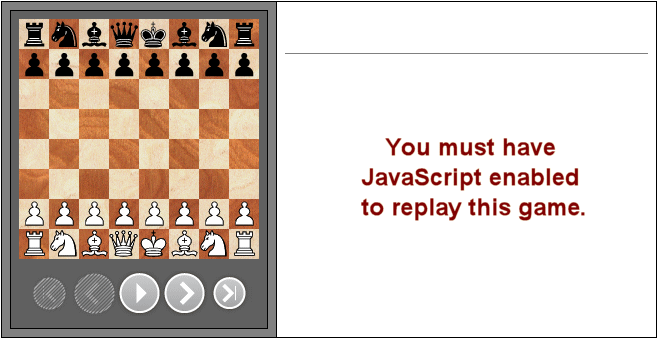
[Event "World Championship 13th"] [Site "Buenos Aires"] [Date "1927.10.15"] [Round "15"] [White "Capablanca, Jose Raul"] [Black "Alekhine, Alexander"] [Result "1/2-1/2"] [ECO "D63"] [Annotator "ChessBase"] [PlyCount "59"] [EventDate "1927.09.16"] [EventType "match"] [EventRounds "34"] [EventCountry "ARG"] [SourceTitle "MainBase"] [Source "ChessBase"] [SourceDate "1999.07.01"] 1. d4 d5 2. c4 e6 3. Nc3 Nf6 4. Bg5 Nbd7 5. e3 Be7 6. Nf3 O-O 7. Rc1 a6 8. a3 h6 9. Bh4 dxc4 10. Bxc4 c5 11. dxc5 Nxc5 12. Be2 b6 13. Qxd8 Bxd8 $6 14. O-O Nb3 15. Rcd1 Bb7 16. Nd2 Nxd2 17. Rxd2 {[#]} Ne4 $1 18. Nxe4 Bxh4 19. Nd6 Bd5 20. e4 Rfd8 21. Nxf7 Kxf7 22. exd5 Rxd5 23. Rxd5 exd5 24. Rd1 Bf6 25. Bf3 Rc8 26. Bxd5+ Ke7 27. b3 Bb2 28. a4 Rc1 29. Rxc1 Bxc1 30. Bc4 1/2-1/2
I love the example, but this is surely more an example of forcing a tactical crisis in the position before the opponent has time to mobilise completely than a demonstration of exchanging to neutralise the opponent’s position. With forcing play, Black sucks White’s pieces forward into Black’s position (Ne4-d6) and while Black’s position is collapsing (20.e4) he manages to aim a low blow at the advanced white knight (20...Rfd8), which leads to wholesale liquidation. The result of the whole operation is indeed mass exchanges, but the amount of calculation and judgement required to ensure that the position resulting after move 23 is completely drawn makes this – in my opinion – something else than a demonstration of the technique of piece exchanges.
This feeling was reinforced by the very next example:

[Event "World Championship 30th"] [Site "Merano"] [Date "1981.11.12"] [Round "15"] [White "Korchnoi, Viktor"] [Black "Karpov, Anatoly"] [Result "1/2-1/2"] [ECO "A29"] [WhiteElo "2695"] [BlackElo "2700"] [PlyCount "80"] [EventDate "1981.10.01"] [EventType "match"] [EventRounds "18"] [EventCountry "ITA"] [SourceTitle "MainBase"] [Source "ChessBase"] [SourceDate "1999.07.01"] 1. c4 Nf6 2. Nc3 e5 3. Nf3 Nc6 4. g3 Bb4 5. Nd5 Bc5 6. Bg2 d6 7. O-O O-O 8. e3 Bg4 9. h3 Bxf3 10. Bxf3 Nxd5 11. cxd5 Ne7 12. b3 Qd7 13. Bg2 c6 14. dxc6 Nxc6 15. Bb2 d5 {[#]Black’s move once again provokes a crisis in the position before White is fully mobilised. After the sequence} 16. Bxe5 Nxe5 17. d4 Bd6 18. dxe5 Bxe5 19. Rc1 d4 20. Rc5 Bf6 21. Rd5 Qc7 22. exd4 Rad8 {White’s extra pawn was not worth that much and Karpov made an easy draw.} 23. Qc1 Qb6 24. Rxd8 Rxd8 25. d5 g6 26. Bf3 Kg7 27. Re1 Rd7 28. Qf4 Re7 29. Rxe7 Bxe7 30. Kg2 a5 31. h4 h5 32. Be2 Bc5 33. Bc4 Qf6 34. Qd2 b6 35. a4 Qe5 36. Qd3 Qf6 37. Qd2 Qe5 38. Be2 Qe4+ 39. Bf3 Qe5 40. Bd1 Qe4+ 1/2-1/2
As in the previous example, the result of the operation was mass exchanges, but I do feel again that the primary defensive technique used here was not really tightly related to the theme of the section.
In general I was lukewarm about the first four sections, which made me all the happier when the last two sections really started to grab my attention. The section on counterattack begins with a very thorough explanation of the famous game Taimanov-Larsen, Vinkovci 1970, where Tiviakov deals with all facets of this defensive technique: technical and psychological.

[Event "Vinkovci"] [Site "Vinkovci"] [Date "1970.10.20"] [Round "13"] [White "Taimanov, Mark E"] [Black "Larsen, Bent"] [Result "0-1"] [ECO "D37"] [PlyCount "68"] [EventDate "1970.10.??"] [EventType "tourn"] [EventRounds "15"] [EventCountry "CRO"] [SourceTitle "MCL"] [Source "ChessBase"] [SourceDate "1999.07.01"] 1. d4 Nf6 2. c4 e6 3. Nc3 Bb4 4. Qc2 c5 5. dxc5 O-O 6. Bf4 Bxc5 7. Nf3 Nc6 8. e3 d5 9. a3 Qa5 10. Rc1 Be7 11. Be2 dxc4 12. Bxc4 Nd5 13. Bxd5 exd5 14. Qb3 { [#]} g5 $3 {In particular, I liked Tiviakov’s insight that counterattack doesn’t necessarily change the evaluation of the position but that the change in the character of the position is often enough to elicit mistakes from the opponent.} 15. Bg3 g4 16. Nd4 Nxd4 17. exd4 Bg5 18. O-O Bxc1 19. Rxc1 Be6 20. h3 gxh3 21. Be5 f6 22. Ne4 fxe5 23. Qg3+ Bg4 24. Qxg4+ Kh8 25. Ng5 Qd2 26. Rc7 Qxf2+ 27. Kh2 Qxg2+ 28. Qxg2 hxg2 29. dxe5 Rac8 30. Rxb7 Rc2 31. Nf7+ Kg7 32. e6 Kf6 33. e7 g1=Q+ 34. Kxg1 Rg8+ 0-1
The DVD rounded off with a very good explanation of prophylaxis in which I particularly enjoyed the 15 minutes Tiviakov spent discussing the game Schlechter-Nimzowitsch.

[Event "Karlsbad"] [Site "Karlsbad"] [Date "1907.09.12"] [Round "17"] [White "Schlechter, Carl"] [Black "Nimzowitsch, Aaron"] [Result "0-1"] [ECO "C77"] [PlyCount "64"] [EventDate "1907.08.20"] [EventType "tourn"] [EventRounds "20"] [EventCountry "CZE"] [SourceTitle "HCL"] [Source "ChessBase"] [SourceDate "1999.07.01"] 1. e4 e5 2. Nf3 Nc6 3. Bb5 a6 4. Ba4 Nf6 5. Nc3 Bb4 6. Nd5 Be7 7. O-O O-O 8. Re1 d6 9. Nxf6+ Bxf6 10. c3 h6 11. h3 Ne7 12. d4 Ng6 13. Be3 Kh7 14. Qd2 Be6 15. Bc2 Qe7 16. d5 Bd7 17. Kh2 {[#]} Nh8 18. Ng1 g5 19. g3 Ng6 20. Qd1 Bg7 21. Qf3 a5 22. Ne2 Bb5 23. a4 Bd7 24. Rh1 Qe8 25. h4 Qc8 26. Bd3 Bg4 27. Qg2 gxh4 28. f3 h3 29. Qf1 f5 30. fxg4 fxe4 31. Qxh3 exd3 32. Bxh6 Rh8 0-1
Tiviakov’s explanation of the plans of both opponents (on both wings) and the cleverness of Nimzowitsch’s choices is masterly and made me look at this well-known fragment in a completely new light. In conclusion, a good DVD, with a slightly weaker start and a very strong finish! Recommended!
You can order Sergei Tiviakov's Art of Defence in the New in Chess Shop.
 Another instalment in Tiviakov’s DVD strategy series is The Art of the Positional Exchange Sacrifice and a very fine achievement it is too!
Another instalment in Tiviakov’s DVD strategy series is The Art of the Positional Exchange Sacrifice and a very fine achievement it is too!
Strangely enough, it’s not the first work on the subject: Russell Enterprises had brought out Sergey Kasparov’s The Exchange Sacrifice: A Practical Guide last year. That book was high on entertainment value, but I found it a little too confusing to be sure I was drawing the correct lessons from it. Tiviakov does the didactic part much better. I really liked the way he started off with a consid-eration of Nimzowitsch’s famous example position from My System.
Nimzowitsch used this as an example of the power of blockade but it’s also a very effective way of giving the viewer a feel for what the Positional Exchange Sacrifice entails and what the advantages could be.
In his ensuing discussion of the position, Tiviakov postulates some very astute ideas about the way you should play after sacrificing the exchange in this way – don’t exchange pieces, use long pawn chains – and he regularly flags these ideas when they come up later in the following sections. The material is based for 90% on classic games of Petrosian, Gligoric and Botvinnik with a few fine efforts from Sergei himself (his game against Van der Weide is particularly good) thrown in for good measure. I enjoyed it greatly, and it definitely had an effect on my thinking. When I reached the following position against Ivan Sokolov on the last day of the 4NCL weekend:

[Event "4NCL 2016/2017"] [Site "Reading ENG"] [Date "2017.05.01"] [Round "11.11"] [White "Matthew Sadler"] [Black "Ivan Sokolov"] [Result "1-0"] [ECO "A60"] [WhiteElo "2670"] [BlackElo "2632"] [PlyCount "79"] [EventDate "2016.11.19"] 1. d4 Nf6 2. c4 c5 3. d5 e6 4. Nc3 exd5 5. cxd5 g6 6. e4 d6 7. f3 a6 8. a4 h5 9. Bg5 {[#] The first idea that popped into my head for Black was ...h4 followed by...Rh5xg5! (Which didn’t happen, as White withdrew his bishop to e3 after 9…Be7. White won, but that was another story – ed.)} Be7 10. Be3 h4 11. Qd2 Nbd7 12. Nh3 Ne5 13. Be2 Rb8 14. O-O Kf8 15. a5 b5 16. axb6 Qxb6 17. b4 Bxh3 18. bxc5 Qb2 19. gxh3 Qxd2 20. Bxd2 Rb2 21. Rfd1 Nh5 22. f4 Rxd2 23. Rxd2 Nxf4 24. c6 Kg7 25. Rc2 Nxh3+ 26. Kf1 Nf4 27. Na4 Bd8 28. Rb1 g5 29. Rb8 Bc7 30. Rxh8 Kxh8 31. Rb2 g4 32. Rb7 h3 33. Kf2 Ba5 34. Bxg4 Nfd3+ 35. Ke3 Nxg4+ 36. Kxd3 Nxh2 37. Nb6 Ng4 38. c7 Nf2+ 39. Ke2 h2 40. c8=Q+ 1-0
All in all, another fantastic effort from Sergei. I think we’ll stretch this one to five stars!
Order Sergei Tiviakov's Art of the Positional Exchange Sacrifice in the NiC Shop.
The above review appeared in the 4/2017 edition of New in Chess magazine.
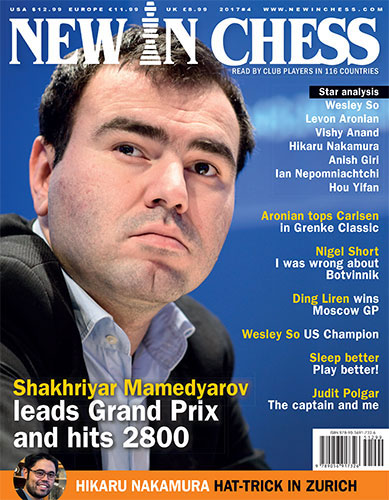
New In Chess (NIC) was founded in 1984 and appears eight times a year. Dirk Jan ten Geuzendam is the editor-in-chief. Besides on-the-spot tournament reports, interviews, chess training and historical articles, the magazine’s hallmark are game comments by the world’s leading players, such as Magnus Carlsen, Vladimir Kramnik, Wesley So, Levon Aronian, Fabiano Caruana, Vishy Anand, Hikaru Nakamura, Maxime Vachier-Lagrave, Anish Giri, Judit Polgar and many others. It is read by club players in 116 countries. A yearly subscription for eight issues costs €79.99 and can be ordered here.
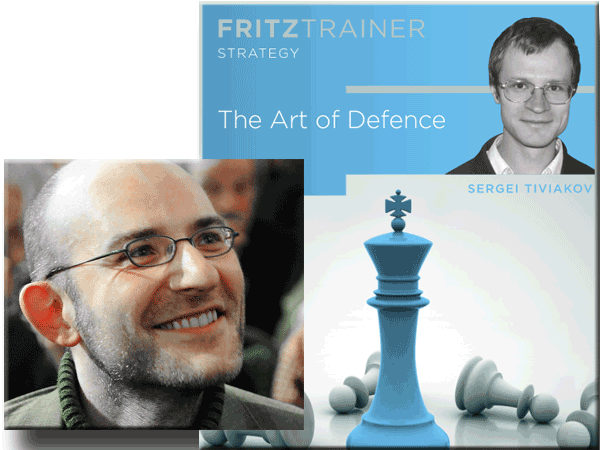













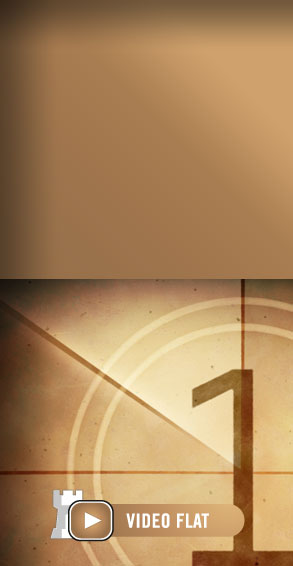


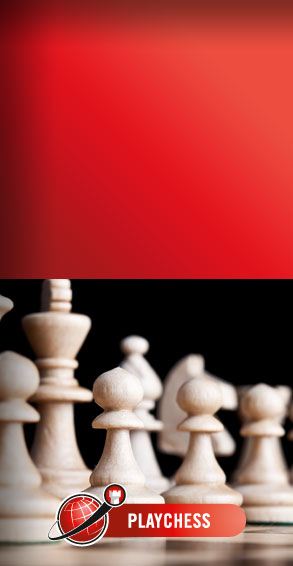

 The past month has been rather hectic as I started a new job after 2½ years working at the same customer. Whenever I change jobs, opening books get traded in for technical manuals and chess takes a back seat. In this case, it was unfortunate timing as the last weekend of the 4NCL was looming with champions Guildford (my team) and challengers Cheddleton neck-and-neck at the top and heading for a last-round shootout. Not the right time to lose interest in chess! I was looking for a low-effort way to keep my feeling for chess alive, and so I was very happy to spot four recent DVD’s on positional themes: two by Sergei Tiviakov and two by Adrian Mikhalchishin. Looking at the titles, I hoped that I would get some instruction and inspiration across a broad range of topics.
The past month has been rather hectic as I started a new job after 2½ years working at the same customer. Whenever I change jobs, opening books get traded in for technical manuals and chess takes a back seat. In this case, it was unfortunate timing as the last weekend of the 4NCL was looming with champions Guildford (my team) and challengers Cheddleton neck-and-neck at the top and heading for a last-round shootout. Not the right time to lose interest in chess! I was looking for a low-effort way to keep my feeling for chess alive, and so I was very happy to spot four recent DVD’s on positional themes: two by Sergei Tiviakov and two by Adrian Mikhalchishin. Looking at the titles, I hoped that I would get some instruction and inspiration across a broad range of topics. We’ll start off with Tiviakov’s The Art of Defence. When reviewing Soltis’ New Art of Defence in New In Chess 2015/2, I mentioned that there were very few good books on this topic. Sergei is renowned as an excellent defender, so I was looking forward to hearing his views on the topic.
We’ll start off with Tiviakov’s The Art of Defence. When reviewing Soltis’ New Art of Defence in New In Chess 2015/2, I mentioned that there were very few good books on this topic. Sergei is renowned as an excellent defender, so I was looking forward to hearing his views on the topic.
 Another instalment in Tiviakov’s DVD strategy series is The Art of the Positional Exchange Sacrifice and a very fine achievement it is too!
Another instalment in Tiviakov’s DVD strategy series is The Art of the Positional Exchange Sacrifice and a very fine achievement it is too!





